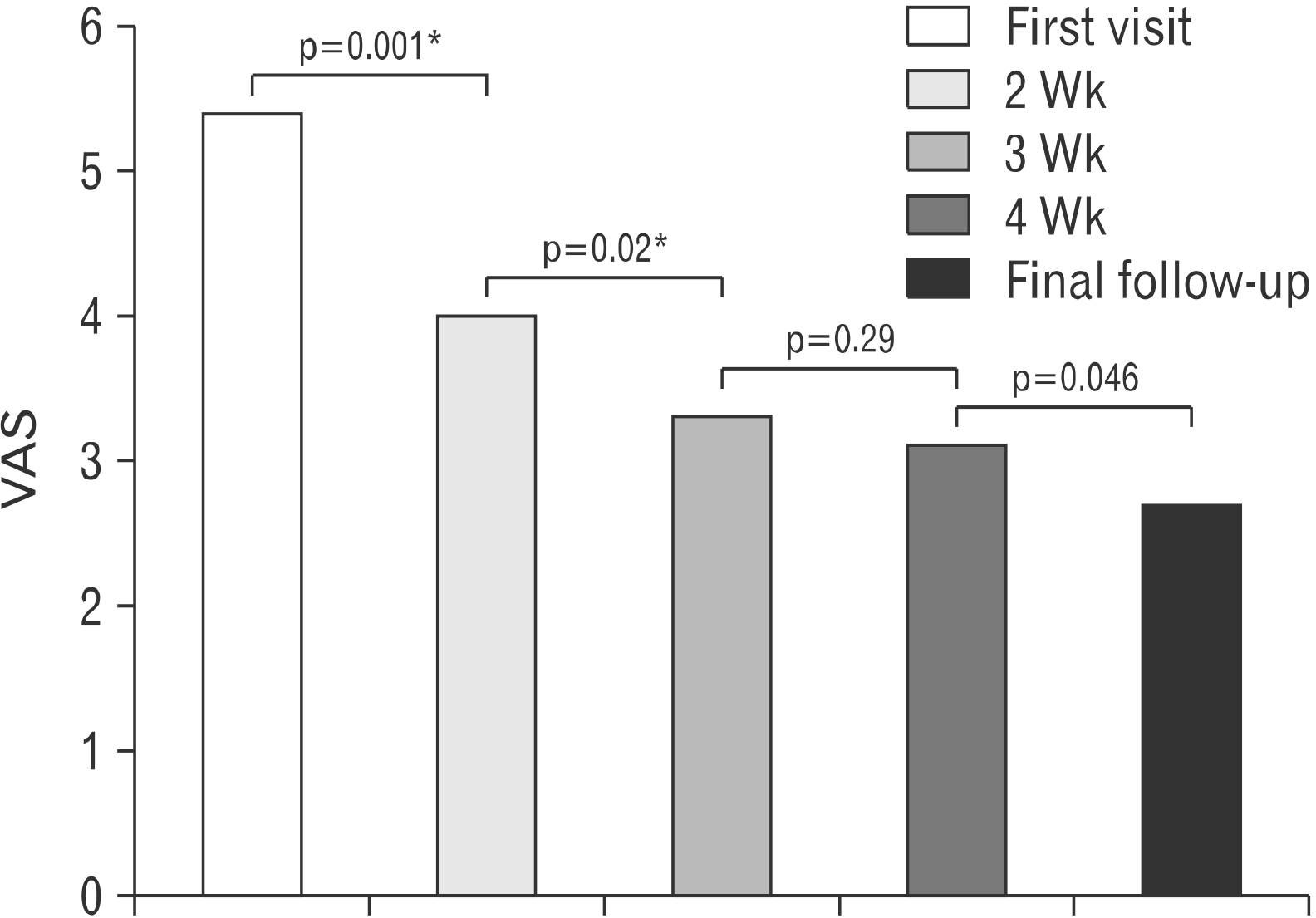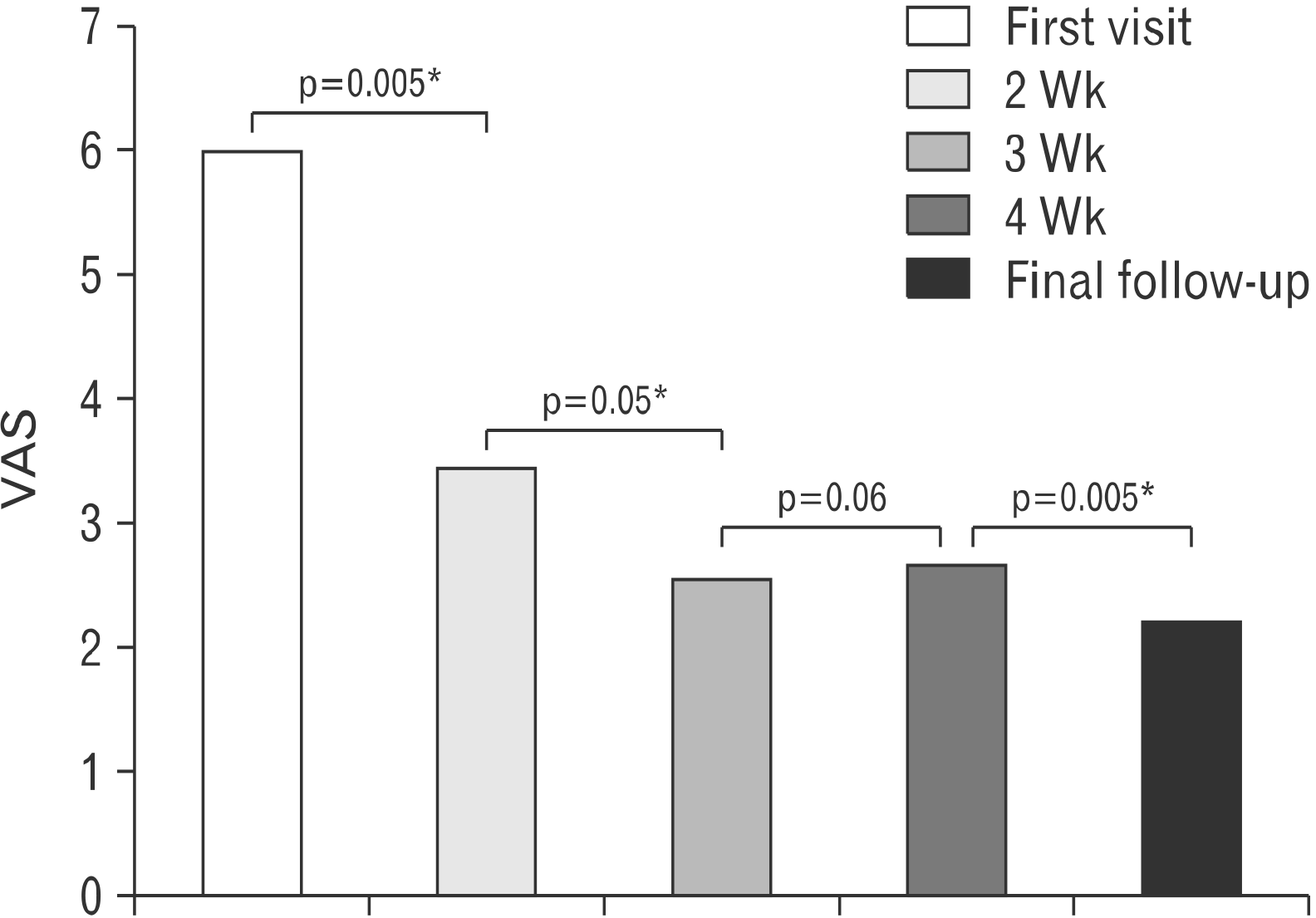1. Kiraly M, Bender T, Hodosi K. 2018; Comparative study of shockwave therapy and low-level laser therapy effects in patients with myofascial pain syndrome of the trapezius. Rheumatol Int. 38:2045–52. DOI:
10.1007/s00296-018-4134-x. PMID:
30171341.

2. Badley EM, Tennant A. 1992; Changing profile of joint disorders with age: findings from a postal survey of the population of Calderdale, West Yorkshire, United Kingdom. Ann Rheum Dis. 51:366–71. DOI:
10.1136/ard.51.3.366. PMID:
1533506. PMCID:
PMC1004663.

4. Okuno H, Takeda T, Sasaoka T, et al. 2008; Relationship between katakori (shoulder stiffness) and shoulder hardness. J Japan Soc Acupunct Moxibustion. 59:30–7. DOI:
10.3777/jjsam.59.30.

5. Brandt M, Sundstrup E, Jakobsen MD, et al. 2014; Association between neck/shoulder pain and trapezius muscle tenderness in office workers. Pain Res Treat. 2014:352735. DOI:
10.1155/2014/352735. PMID:
24800070. PMCID:
PMC3985383.

6. van der Windt DA, Thomas E, Pope DP, et al. 2000; Occupational risk factors for shoulder pain: a systematic review. Occup Environ Med. 57:433–42. DOI:
10.1136/oem.57.7.433. PMID:
10854494. PMCID:
PMC1739981.

7. Gerwin RD. 2005; A review of myofascial pain and fibromyalgia: factors that promote their persistence. Acupunct Med. 23:121–34. DOI:
10.1136/aim.23.3.121. PMID:
16259310.
8. Cho YS, Park SJ, Jang SH, Choi YC, Lee JH, Kim JS. 2012; Effects of the combined treatment of extracorporeal shock wave therapy (ESWT) and stabilization exercises on pain and functions of patients with myofascial pain syndrome. J Phys Ther Sci. 24:1319–23. DOI:
10.1589/jpts.24.1319.

9. Fisher AA, Chang CH. 1986; Temperature and pressure threshold measurement in trigger points. Thermology. 1:212–5.
10. Travell JG, Simons DG. 1983. Myofascial pain and dysfunction. the trigger point manual. Volume 1:Williams &Wilkins;Baltimore, MD: p. 37–40.
11. Ramon S, Gleitz M, Hernandez L, Romero LD. 2015; Update on the efficacy of extracorporeal shockwave treatment for myofascial pain syndrome and fibromyalgia. Int J Surg. 24(Pt B):201–6. DOI:
10.1016/j.ijsu.2015.08.083. PMID:
26363497.

12. Yap EC. 2007; Myofascial pain: an overview. Ann Acad Med Singap. 36:43–8. PMID:
17285185.
14. Ramon S, Hernandez-Sierra L, Gomez-Centeno A, Ares O, Garcia-Manrique de Lara M, Vidiella F, Cugat R. 2014. Radial extracorporeal shockwave therapy in fibromyalgia. In : Proceedings of the 17th International Congress of the International Society for Medical Shockwave Treatment; 2014 Jun 26-28; Milan, Italy. ISMST.
15. Heller KD, Niethard FU. 1998; Using extracorporeal shockwave therapy in orthopedics: a meta-analysis. Z Orthop Ihre Grenzgeb. 136:390–401. DOI:
10.1055/s-2008-1053674. PMID:
9823633.
16. Muller-Ehrenberg H, Licht G. 2005; Diagnosis and therapy of myofascial pain syndrome with focused shock waves (ESWT). Med Orthop Tech. 5:1–6.
17. Gur A, Koca I, Karagullu H, Altindag O, Madenci E. 2013; Comparison of the efficacy of ultrasound and extracorporeal shock wave therapies in patients with myofascial pain syndrome: a randomized controlled study. J Musculoskelet Pain. 21:210–6. DOI:
10.3109/10582452.2013.828824.

18. Hong JO, Park JS, Jeon DG, Yoon WH, Park JH. 2017; Extracorporeal shock wave therapy versus trigger point injection in the treatment of myofascial pain syndrome in the quadratus lumborum. Ann Rehabil Med. 41:582–8. DOI:
10.5535/arm.2017.41.4.582. PMID:
28971042. PMCID:
PMC5608665.

20. Zimmermann R, Cumpanas A, Miclea F, Janetschek G. 2009; Extracorporeal shock wave therapy for the treatment of chronic pelvic pain syndrome in males: a randomised, double-blind, placebo-controlled study. Eur Urol. 56:418–24. DOI:
10.1016/j.eururo.2009.03.043. PMID:
19372000.
21. Hausdorf J, Lemmens MA, Heck KD, et al. 2008; Selective loss of unmyelinated nerve fibers after extracorporeal shockwave application to the musculoskeletal system. Neuroscience. 155:138–44. DOI:
10.1016/j.neuroscience.2008.03.062. PMID:
18579315.

22. Hausdorf J, Lemmens MA, Kaplan S, et al. 2008; Extracorporeal shockwave application to the distal femur of rabbits diminishes the number of neurons immunoreactive for substance P in dorsal root ganglia L5. Brain Res. 1207:96–101. DOI:
10.1016/j.brainres.2008.02.013. PMID:
18371941.

23. Wang CJ, Wang FS, Yang KD, et al. 2003; Shock wave therapy induces neovascularization at the tendon-bone junction: a study in rabbits. J Orthop Res. 21:984–9. DOI:
10.1016/S0736-0266(03)00104-9. PMID:
14554209.

24. Davis TA, Stojadinovic A, Anam K, et al. 2009; Extracorporeal shock wave therapy suppresses the early proinflammatory immune response to a severe cutaneous burn injury. Int Wound J. 6:11–21. DOI:
10.1111/j.1742-481X.2008.00540.x. PMID:
19291111.

25. Kvalvaag E, Brox JI, Engebretsen KB, et al. 2017; Effectiveness of radial extracorporeal shock wave therapy (rESWT) when combined with supervised exercises in patients with subacromial shoulder pain: a double-masked, randomized, sham- controlled trial. Am J Sports Med. 45:2547–54. DOI:
10.1177/0363546517707505. PMID:
28586628.
26. Chuckpaiwong B, Berkson EM, Theodore GH. 2009; Extracorporeal shock wave for chronic proximal plantar fasciitis: 225 patients with results and outcome predictors. J Foot Ankle Surg. 48:148–55. DOI:
10.1053/j.jfas.2008.11.001. PMID:
19232966.

27. Kudo P, Dainty K, Clarfield M, Coughlin L, Lavoie P, Lebrun C. 2006; Randomized, placebo-controlled, double-blind clinical trial evaluating the treatment of plantar fasciitis with an extracoporeal shockwave therapy (ESWT) device: a North American confirmatory study. J Orthop Res. 24:115–23. DOI:
10.1002/jor.20008. PMID:
16435344.

28. Liao CD, Tsauo JY, Chen HC, Liou TH. 2018; Efficacy of extracorporeal shock wave therapy for lower-limb tendinopathy: a meta-analysis of randomized controlled trials. Am J Phys Med Rehabil. 97:605–19. DOI:
10.1097/PHM.0000000000000925. PMID:
29557811.




 PDF
PDF Citation
Citation Print
Print





 XML Download
XML Download